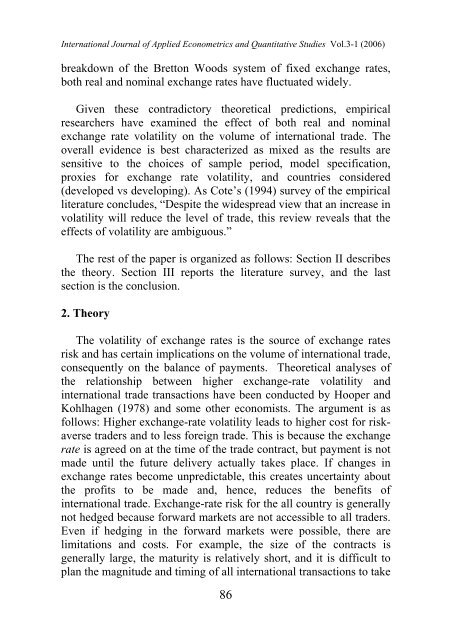EXCHANGE RATE VOLATILITY AND TRADE: A LITERATURE ...
EXCHANGE RATE VOLATILITY AND TRADE: A LITERATURE ...
EXCHANGE RATE VOLATILITY AND TRADE: A LITERATURE ...
You also want an ePaper? Increase the reach of your titles
YUMPU automatically turns print PDFs into web optimized ePapers that Google loves.
International Journal of Applied Econometrics and Quantitative Studies Vol.3-1 (2006)<br />
breakdown of the Bretton Woods system of fixed exchange rates,<br />
both real and nominal exchange rates have fluctuated widely.<br />
Given these contradictory theoretical predictions, empirical<br />
researchers have examined the effect of both real and nominal<br />
exchange rate volatility on the volume of international trade. The<br />
overall evidence is best characterized as mixed as the results are<br />
sensitive to the choices of sample period, model specification,<br />
proxies for exchange rate volatility, and countries considered<br />
(developed vs developing). As Cote’s (1994) survey of the empirical<br />
literature concludes, “Despite the widespread view that an increase in<br />
volatility will reduce the level of trade, this review reveals that the<br />
effects of volatility are ambiguous.”<br />
The rest of the paper is organized as follows: Section II describes<br />
the theory. Section III reports the literature survey, and the last<br />
section is the conclusion.<br />
2. Theory<br />
The volatility of exchange rates is the source of exchange rates<br />
risk and has certain implications on the volume of international trade,<br />
consequently on the balance of payments. Theoretical analyses of<br />
the relationship between higher exchange-rate volatility and<br />
international trade transactions have been conducted by Hooper and<br />
Kohlhagen (1978) and some other economists. The argument is as<br />
follows: Higher exchange-rate volatility leads to higher cost for riskaverse<br />
traders and to less foreign trade. This is because the exchange<br />
rate is agreed on at the time of the trade contract, but payment is not<br />
made until the future delivery actually takes place. If changes in<br />
exchange rates become unpredictable, this creates uncertainty about<br />
the profits to be made and, hence, reduces the benefits of<br />
international trade. Exchange-rate risk for the all country is generally<br />
not hedged because forward markets are not accessible to all traders.<br />
Even if hedging in the forward markets were possible, there are<br />
limitations and costs. For example, the size of the contracts is<br />
generally large, the maturity is relatively short, and it is difficult to<br />
plan the magnitude and timing of all international transactions to take<br />
86

















